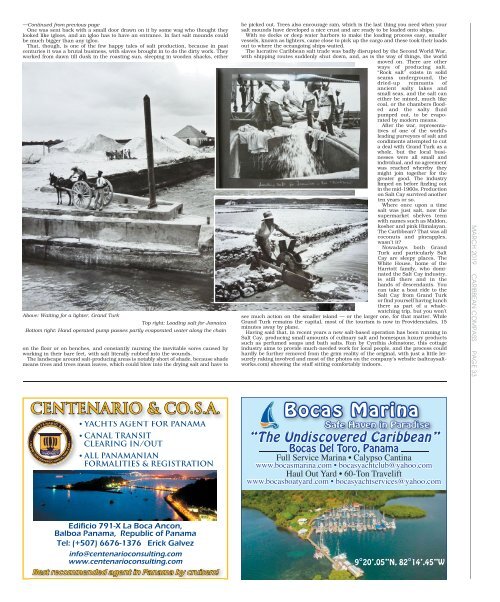Caribbean Compass Yachting Magazine - March 2019
Welcome to Caribbean Compass, the most widely-read boating publication in the Caribbean! THE MOST NEWS YOU CAN USE - feature articles on cruising destinations, regattas, environment, events...
Welcome to Caribbean Compass, the most widely-read boating publication in the Caribbean! THE MOST NEWS YOU CAN USE - feature articles on cruising destinations, regattas, environment, events...
You also want an ePaper? Increase the reach of your titles
YUMPU automatically turns print PDFs into web optimized ePapers that Google loves.
— Continued from previous page<br />
One was sent back with a small door drawn on it by some wag who thought they<br />
looked like igloos, and an igloo has to have an entrance. In fact salt mounds could<br />
be much bigger than any igloo.<br />
That, though, is one of the few happy tales of salt production, because in past<br />
centuries it was a brutal business, with slaves brought in to do the dirty work. They<br />
worked from dawn till dusk in the roasting sun, sleeping in wooden shacks, either<br />
Above: Waiting for a lighter, Grand Turk<br />
Top right: Loading salt for Jamaica<br />
Bottom right: Hand operated pump passes partly evaporated water along the chain<br />
on the floor or on benches, and constantly nursing the inevitable sores caused by<br />
working in their bare feet, with salt literally rubbed into the wounds.<br />
The landscape around salt-producing areas is notably short of shade, because shade<br />
means trees and trees mean leaves, which could blow into the drying salt and have to<br />
be picked out. Trees also encourage rain, which is the last thing you need when your<br />
salt mounds have developed a nice crust and are ready to be loaded onto ships.<br />
With no docks or deep water harbors to make the loading process easy, smaller<br />
vessels, known as lighters, came close to pick up the cargo and these took their loads<br />
out to where the oceangoing ships waited.<br />
The lucrative <strong>Caribbean</strong> salt trade was badly disrupted by the Second World War,<br />
with shipping routes suddenly shut down, and, as is the way of things, the world<br />
moved on. There are other<br />
ways of producing salt.<br />
“Rock salt” exists in solid<br />
seams underground, the<br />
dried-up remnants of<br />
ancient salty lakes and<br />
small seas, and the salt can<br />
either be mined, much like<br />
coal, or the chambers flooded<br />
and the salty fluid<br />
pumped out, to be evaporated<br />
by modern means.<br />
After the war, representatives<br />
of one of the world’s<br />
leading purveyors of salt and<br />
condiments attempted to cut<br />
a deal with Grand Turk as a<br />
whole, but the local businesses<br />
were all small and<br />
individual, and no agreement<br />
was reached whereby they<br />
might join together for the<br />
greater good. The industry<br />
limped on before fizzling out<br />
in the mid-1960s. Production<br />
on Salt Cay survived another<br />
ten years or so.<br />
Where once upon a time<br />
salt was just salt, now the<br />
supermarket shelves teem<br />
with names such as Maldon,<br />
kosher and pink Himalayan.<br />
The <strong>Caribbean</strong>? That was all<br />
coconuts and pineapples,<br />
wasn’t it?<br />
Nowadays both Grand<br />
Turk and particularly Salt<br />
Cay are sleepy places. The<br />
White House, home of the<br />
Harriott family, who dominated<br />
the Salt Cay industry,<br />
is still there and in the<br />
hands of descendants. You<br />
can take a boat ride to the<br />
Salt Cay from Grand Turk<br />
or find yourself having lunch<br />
there as part of a whalewatching<br />
trip, but you won’t<br />
see much action on the smaller island — or the larger one, for that matter. While<br />
Grand Turk remains the capital, most of the tourism is now in Providenciales, 15<br />
minutes away by plane.<br />
Having said that, in recent years a new salt-based operation has been running in<br />
Salt Cay, producing small amounts of culinary salt and homespun luxury products<br />
such as perfumed soaps and bath salts. Run by Cynthia Johnstone, this cottage<br />
industry aims to provide much-needed work for local people, and the process could<br />
hardly be further removed from the grim reality of the original, with just a little leisurely<br />
raking involved and most of the photos on the company’s website (saltcaysaltworks.com)<br />
showing the staff sitting comfortably indoors.<br />
MARCH <strong>2019</strong> CARIBBEAN COMPASS PAGE 33<br />
CENTENARIO & CO.S.A.<br />
• YACHTS AGENT FOR PANAMA<br />
• CANAL TRANSIT<br />
CLEARING IN/OUT<br />
• ALL PANAMANIAN<br />
FORMALITIES & REGISTRATION<br />
Bocas Marina<br />
Safe Haven in Paradise<br />
“The Undiscovered d <strong>Caribbean</strong>”<br />
Bocas Del Toro, Panama<br />
Full Service Marina • Calypso Cantina<br />
www.bocasmarina.com • bocasyachtclub@yahoo.com<br />
Haul Out Yard • 60-Ton Travelift<br />
www.bocasboatyard.com • bocasyachtservices@yahoo.com<br />
Edificio 791-X La Boca Ancon,<br />
Balboa Panama, Republic of Panama<br />
Tel: (+507) 6676-1376 Erick Galvez<br />
info@centenarioconsulting.com<br />
www.centenarioconsulting.com<br />
Best recommended agent in Panama by cruisers!<br />
9°20’.05”N, 82°14’.45”W


















